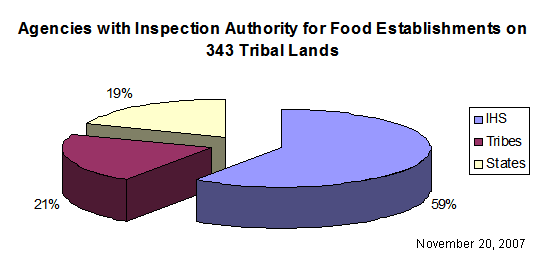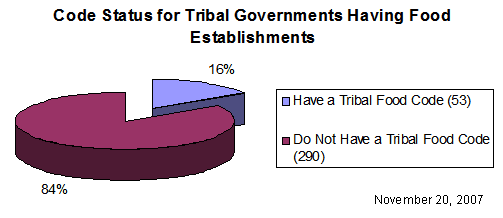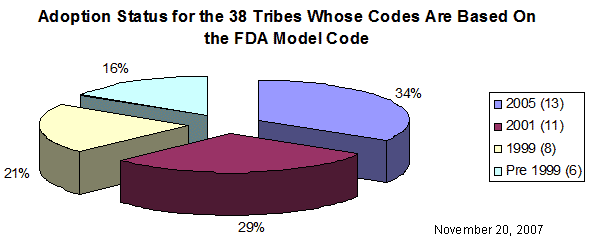|
May 2002; Quarterly update November 2007
The Association of Food and Drug Officials (AFDO), under contract to the Food and Drug Administration, is gathering data on the progress of FDA Food Code adoptions by States, Territories, Local and Tribal Nation agencies. Adoption of the Food Code represents a successful federal/state/local partnership in improving food safety. FDA and AFDO's goal is the prevention and reduction of foodborne illness and death from food produced at the retail level. Adoption of the Food Code by all food safety agencies at the federal, state, local and tribal levels establishes a sound regulatory foundation and legal framework for uniformity in achieving such a reduction.
Since the last quarterly report, the state and territorial retail food agencies were surveyed by the revised "FDA Food Code Adoption Survey", OMB #0910-0448 to gather detailed information pertaining to obstacles encountered during rulemaking, determining whether state agency codes are lacking FDA Model Code elements, and soliciting feedback on assistance that FDA can provide in order to support state rulemaking processes. Fifty state agencies, representing 42 of the 50 states, responded for an 84% response rate.
AFDO reports that 48 of the 50 States (96%) and 3 of the 6 Territories (50%) have adopted codes patterned after the 1993, 1995, 1997, 1999, 2001 or 2005 versions of the Food Code. Those 51 states and territories represent 95.7% of the US population. Of the remaining 5 States and Territories:
Fourteen of the 56 States and Territories have adopted the 1999 Food Code, representing 15.2% of the US population.
Twenty of the 56 States and Territories have adopted the 2001 Food Code, representing 57.7% of the US population.
Nine of the 56 States and Territories have adopted the 2005 Food Code, representing 11.0% of the US population.
For a helpful summary of American Indian Food Issues, please see a PowerPoint presentation, The Indian Health Service, Food Safety Briefing, given on May 6, 2003 by Alan Dellapenna, Deputy Director of Environmental Health Services, Indian Health Service.
The following information, current as of November 2007, is provided by the Indian Health Service:
Out of the 560+ federally recognized tribes, 343 have food service operations on their lands. The agencies that perform food inspections for the 343 tribes are shown below.

Of the 343 tribes with food service operations, the majority have not adopted a tribal food code. This is depicted below.

Of the fifty three (53) tribes that have a tribal food code, the majority are based on a version of the FDA Model Food Code as shown below.

Of the thirty eight (38) tribes whose codes are based on the FDA Model Food Code, the years of the editions are depicted below.

Adopted the Food Code means that one or more of the retail food program agencies in the state modeled its code after the 1993, 1995, 1997, 1999, 2001, or 2005 version of the FDA Model Food Code.
Adopted the 1999 Food Code means that one or more of the retail food program agencies in the state modeled its code after the 1999 version of the FDA Model Food Code. See Map C for States and Territories that have adopted the 2001 version of the Food Code.
| State or Territory | 2000 Census | Retail Food Program Agency | Agency Food Code Status | Rule Making |
|---|---|---|---|---|
| Alabama | 4,447,100 | Department of Public Health | Has adopted the Food Code - 2001 | Yes - 2007 |
| Alaska | 626,932 | Dep't of Environmental Conservation | Has adopted the Food Code - 2005 | No |
| American Samoa | 57,291 | Did not respond to survey | ||
| Arizona | 5,130,632 | Department of Health Services | Has adopted the Food Code - 1999 | Yes - 2007 |
| Arkansas | 2,673,400 | Department of Health | Has adopted the Food Code - 2001 | No |
| California | 33,871,648 | Department of Health Services | Has adopted the Food Code - 2001 | Yes - 2009 |
| Colorado | 4,301,261 | Dep't of Public Health and Env | Has adopted the Food Code - 2001 | Yes - 2008 |
| Connecticut | 3,405,565 | Department of Consumer Protection | Has adopted the Food Code - 1999 | No |
| Department of Public Health | Has adopted the Food Code - 1997 | Yes - 2008 | ||
| Delaware | 783,600 | Dep't of Health and Social Services | Has adopted the Food Code - 1999 | Yes - 2007 |
| District of Columbia | 572,059 | Department of Health | Has adopted the Food Code - 1999 | No |
| Florida | 15,982,378 | Department of Agriculture | Has adopted the Food Code - 2001 | Yes - 2007 |
| Dep't of Bus and Prof Regulation | Has adopted the Food Code - 2001 | No | ||
| Department of Health | Has adopted the Food Code - 2001 | No | ||
| Georgia | 8,186,453 | Department of Agriculture | Has adopted the Food Code - 2001 | No |
| Department of Human Resources | Has adopted the Food Code - 2005 | No | ||
| Guam | 154,805 | Department of Public Health | Has not adopted the Food Code | Unknown |
| Hawaii | 1,211,537 | Department of Health | Has adopted the Food Code - 1997 | No |
| Idaho | 1,293,953 | Department of Health and Welfare | Has adopted the Food Code - 2001 | Yes - 2008 |
| Illinois | 12,419,293 | Department of Public Health | Has adopted the Food Code - 1995 | Yes - 2007 |
| Indiana | 6,080,485 | Department of Health | Has adopted the Food Code - 2001 | No |
| Iowa | 2,926,324 | Dep't of Inspections and Appeals | Has adopted the Food Code - 1997 | Yes - 2007 |
| Kansas | 2,688,418 | Dep't of Health and Environment | Has adopted the Food Code - 2005 | No |
| Kentucky | 4,041,769 | Department of Public Health | Based on 1976 Model Foodservice Code | Yes - 2008 |
| Louisiana | 4,468,976 | Department of Health and Hospitals | Has adopted the Food Code - 1999 | Yes - 2007 |
| Maine | 1,274,923 | Department of Agriculture | Has adopted the Food Code - 1999 | Yes - 2007 |
| Department of Human Services | Has adopted the Food Code - 1999 | No | ||
| Maryland | 5,296,486 | Dep't of Health and Mental Hygiene | Has adopted the Food Code – 1997 | Yes - 2008 |
| Massachusetts | 6,349,097 | Department of Public Health | Has adopted the Food Code - 1999 | No |
| Michigan | 9,938,444 | Department of Agriculture | Has adopted the Food Code - 2005 | No |
| Minnesota | 4,919,479 | Department of Agriculture | Has adopted the Food Code - 1995 | No |
| Department of Health | Has adopted the Food Code - 1995 | No | ||
| Mississippi | 2,844,658 | Department of Agriculture | Has adopted the Food Code - 2005 | No |
| Department of Health | Has adopted the Food Code - 2005 | No | ||
| Missouri | 5,595,211 | Department of Health | Has adopted the Food Code - 1999 | Yes- 2008 |
| Montana | 902,195 | Department of Health | Has adopted the Food Code - 1999 | No |
| Nebraska | 1,711,263 | Department of Agriculture | Has adopted the Food Code - 2005 | No |
| Nevada | 1,998,257 | Department of Health | Has adopted the Food Code - 1993 | Yes - 2007 |
| New Hampshire | 1,235,786 | Department of Health and Welfare | Has adopted the Food Code - 2001 | Yes - 2008 |
| New Jersey | 8,414,350 | Dep't of Health and Senior Services | Has adopted the food code - 2001 | No |
| New Mexico | 1,819,046 | Environment Department | Has adopted the Food Code - 1999 | No |
| New York | 18,976,457 | Department of Agriculture | Has adopted the Food Code - 2001 | Yes - 2008 |
| Department of Health | Based on 1976 Model Foodservice Code | Yes - 2008 | ||
| North Carolina | 8,049,313 | Department of Agriculture | Has adopted 21 CFR, Part 110 | No |
| Dep't of Env and Nat'l Resources | Based on 1976 Model Foodservice Code | Yes - unknown | ||
| North Dakota | 642,200 | Department of Health | Has adopted the Food Code - 2001 | Yes - 2008 |
| Northern Mariana Islands | 69,221 | Did not respond to survey | ||
| Ohio | 11,353,140 | Department of Agriculture | Has adopted the Food Code - 2001 | Yes - 2008 |
| Department of Health | Has adopted the Food Code - 2001 | Yes - 2008 | ||
| Oklahoma | 3,450,654 | Department of Health | Has adopted the Food Code - 2001 | No |
| Oregon | 3,421,399 | Department of Agriculture | Has adopted the Food Code - 1999 | Yes - 2008 |
| Department of Health | Has adopted the Food Code - 1999 | No | ||
| Pennsylvania | 12,281,054 | Department of Agriculture | Has adopted the Food Code - 2001 | No |
| Puerto Rico | 3,808,610 | Department of Health | Has adopted the Food Code - 2005 | No |
| Rhode Island | 1,048,319 | Department of Health | Has adopted the Food Code - 2005 | No |
| South Carolina | 4,012,012 | Department of Health | Has adopted the Food Code - 1993 | Yes |
| South Dakota | 754,844 | Department of Health | Has adopted the Food Code - 1995 | Yes - 2007 |
| Tennessee | 5,689,283 | Department of Agriculture | Based on 1982 Model Retail Foodstore Code | No |
| Department of Health | Has adopted the Food Code - 1999 | No | ||
| Texas | 20,851,820 | Department of Health | Has adopted the Food Code - 2001 | No |
| US Virgin Islands | 108,612 | Department of Health | Has adopted the Food Code - 2001 | No |
| Utah | 2,233,169 | Department of Agriculture | Has adopted the Food Code - 1999 | Yes - 2007 |
| Department of Health | Has adopted the Food Code - 1999 | Yes - 2007 | ||
| Vermont | 608,827 | Department of Health | Has adopted the Food Code - 2001 | No |
| Virginia | 7,078,515 | Department of Agriculture | Has adopted the Food Code - 2001 | No |
| Department of Health | Has adopted the Food Code - 2001 | No | ||
| Washington | 5,894,121 | Department of Health | Has adopted the Food Code - 2001 | No |
| West Virginia | 1,808,344 | Department of Health | Has adopted the Food Code - 1999 | Yes - 2008 |
| Wisconsin | 5,363,675 | Department of Agriculture | Has adopted the Food Code - 2001 | No |
| Department of Health | Has adopted the Food Code - 1999 | No | ||
| Wyoming | 493,782 | Department of Agriculture | Has adopted the Food Code - 2005 | No |
Map A: States and Territories that have adopted the Food Code
Description: Color coded map of the United States and its territories depicting which states have adopted a version of the FDA Food Code, which states have not adopted the food code but have rulemaking in progress, and which states did not respond to the survey. States and territories that have adopted a version of the food code are California, Maryland, Maine, New York, Pennsylvania, New Hampshire, Vermont, Massachusetts, Rhode Island, Connecticut, New Jersey, Delaware, West Virginia, Virginia, the District of Columbia, South Carolina, Georgia, Florida, Alabama, Tennessee, Ohio, Indiana, Michigan, Wisconsin, Illinois, Mississippi, Arkansas, Louisiana, Missouri, Iowa, Minnesota, North Dakota, South Dakota, Nebraska, Kansas, Oklahoma, Texas, Montana, Wyoming, Colorado, Idaho, Utah, Arizona, New Mexico, Nevada, Oregon, Washington, Alaska, Hawaii, the Virgin Islands, and Puerto Rico. States and territories that have not adopted the food code but have rulemaking in progress are North Carolina, Kentucky, and Guam. The North Mariana Islands, American Samoa, and Guam did not respond to the 2004 survey.
Map B: States and Territories that have adopted the 1999 Food Code
Description: Color coded map of the United States and its territories depicting which states have adopted the 1999 FDA Food Code, which states have not adopted the 1999 FDA Food Code, and indicates which states did not complete the survey and therefore it is unknown if they have adopted the 1999 FDA Food Code. Maine, Massachusetts, Connecticut, Delaware, the District of Columbia, West Virginia, Tennessee, Louisiana, Missouri, Montana, Utah, Arizona, New Mexico, and Oregon have adopted the 1999 Food Code. The North Mariana Islands and American Samoa did not respond to the survey and adoption of the 1999 FDA Food Code is unknown. All other states and territories have not adopted the 1999 FDA Food Code.
Map C: States and Territories that have adopted the 2001 Food Code.
Description: Color coded map of the United States and its territories depicting which states have adopted the 2001 FDA Food Code, which states have not adopted the 2001 FDA Food Code, and indicates which states did not complete the survey and therefore it is unknown if they have adopted the 2001 FDA Food Code. California, New York, Wisconsin, Oklahoma, Colorado, Idaho, Texas, Alabama, New Jersey, New Hampshire, Florida, Pennsylvania, Virginia, North Dakota, Vermont, Ohio, Indiana, Arkansas, Washington, and the Virgin Islands have adopted the 2001 Food Code. The North Mariana Islands and American Samoa did not respond to the survey and adoption of the 2001 FDA Food Code is unknown. All other states and territories have not adopted the 2001 FDA Food Code.
Map D: States and Territories that have adopted the 2005 Food Code.
Description: Color coded map of the United States and its territories depicting which states have adopted the 2005 FDA Food Code, which states have not adopted the 2005 FDA Food Code, and indicates which states did not complete the survey and therefore it is unknown if they have adopted the 2005 FDA Food Code. Georgia, Kansas, Michigan, Nebraska, Wyoming, Alaska, Mississippi, Rhode Island, and Puerto Rico have adopted the 2005 Food Code. The North Mariana Islands and American Samoa did not respond to the survey and adoption of the 2005 FDA Food Code is unknown. All other states and territories have not adopted the 2005 FDA Food Code.
Graph A: Population of States and Territories That Have Adopted the Food Code
Description: A bar graph indicating the percentage of the U.S. population that reside in states that have adopted codes patterned after either the 1993, 1995, 1997, 1999, 2001, or 2005 versions of the FDA Food Code. The Y axis scale goes from 0 to 250 million and indicates the number of persons in the United States and the X axis scale indicates Survey Year 2001, Survey Year 2002, Survey Year 2003, Survey Year 2004, Survey Year 2005 and Survey Year 2006. The bar for 2001 indicates 72% of the population resided in a state that has adopted a version of the FDA Food Code. The bars for 2002, 2003, 2004, 2005, 2006, and 2007 indicate that 76%, 80%, 79%, 79%, 79% and 96% respectively, of the population resides in a state that has adopted a version of the FDA Food Code.